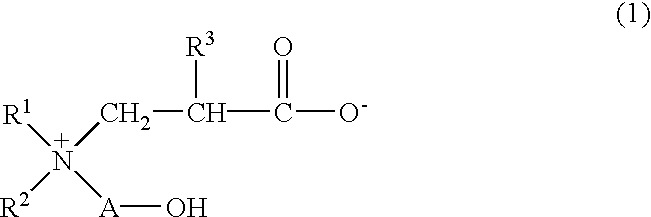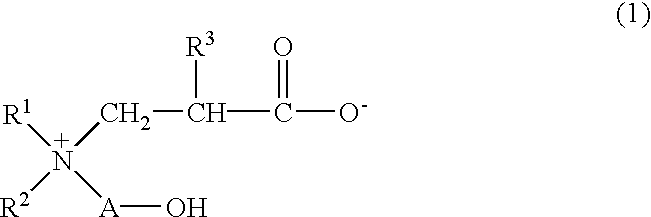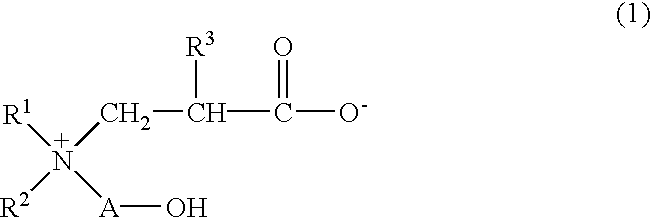Betaine compound and process for production thereof
a technology of betaine compound and process, which is applied in the preparation of carboxylic acid amides, organic chemistry, fatty acid chemical modifications, etc., can solve the problem that the yield of long-chain alkyl group-containing betaine compound cannot be good, and achieve the effect of good yield
- Summary
- Abstract
- Description
- Claims
- Application Information
AI Technical Summary
Problems solved by technology
Method used
Image
Examples
reference example 1
Synthesis of N,N-di-n-Butyl-.beta.-alanine
A 300 ml four-necked flask equipped with a stirrer, condenser, thermometer and drip funnel was charged with 100 g (0.7738 mol) of di-n-butylamine and while the internal temperature was maintained at .ltoreq.30.degree. C. on an iced-water bath, a mixture of 55.7 g (0.7730 mol) of acrylic acid and 0.1 g of phenothiazine was added dropwise over 30 minutes. After completion of dropwise addition, the reaction was carried out under heating on an oil bath at 80.degree. C. for 4 hours.
After completion of the reaction, acrylic acid and di-n-butylamine were assayed by gas chromatography. As a result, formation of 152.5 g (yield 98%) of N,N-di-n-butyl-.beta.-alanine was confirmed, with the rates of conversion of acrylic acid and di-n-butylamine being 98% and 98%, respectively.
reference example 2
Synthesis of N,N-di-n-Pentyl-.beta.-alanine
A 100 ml four-necked flask equipped with a stirrer, condenser, thermometer and drip funnel was charged with 50 g (0.3179 mol) of di-n-pentylamine and while the internal temperature was maintained at .ltoreq.30.degree. C. on an iced-water bath, a mixture of 22.9 g (0.3178 mol) of acrylic acid and 0.05 g of phenothiazine was added dropwise over 30 minutes. After completion of dropwise addition, the reaction was carried out under heating on an oil bath at 80.degree. C. for 4 hours.
After completion of the reaction, acrylic acid and di-n-pentylamine were assayed by gas chromatography. As a result, formation of 69.2 g (yield 95%) of N,N-di-n-pentyl-.beta.-alanine was confirmed, with the rates of conversion of acrylic acid and di-n-pentylamine being 95% and 95%, respectively.
reference example 3
Synthesis of N,N-di-(2-Hydroxy)ethyl-.beta.-alanine
A 100 ml four-necked flask equipped with a stirrer, condenser, thermometer and drip funnel was charged with 50 g (0.4756 mol) of di (2-hydroxy) ethylamine and while the internal temperature was maintained at .ltoreq.30.degree. C. on an iced-water bath with stirring, a mixture of 34.2 g (0.4751 mol) of acrylic acid and 0.02 g of phenothiazine was added dropwise over 1 hour. After completion of dropwise addition, the reaction was carried out under heating on an oil bath at 80.degree. C. for 3 hours.
After completion of the reaction, acrylic acid and di(2-hydroxy)ethylamine were assayed by gas chromatography. As a result, formation of 83.3 g (yield 99%) of N,N-di(2-hydroxy)ethyl-.beta.-alanine was confirmed, with the rates of conversion of acrylic acid and di(2-hydroxy)ethylamine being 99% and 99%, respectively.
PUM
 Login to View More
Login to View More Abstract
Description
Claims
Application Information
 Login to View More
Login to View More - R&D
- Intellectual Property
- Life Sciences
- Materials
- Tech Scout
- Unparalleled Data Quality
- Higher Quality Content
- 60% Fewer Hallucinations
Browse by: Latest US Patents, China's latest patents, Technical Efficacy Thesaurus, Application Domain, Technology Topic, Popular Technical Reports.
© 2025 PatSnap. All rights reserved.Legal|Privacy policy|Modern Slavery Act Transparency Statement|Sitemap|About US| Contact US: help@patsnap.com



